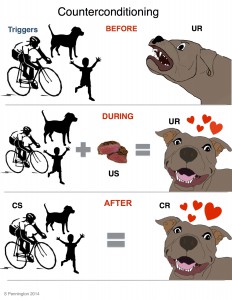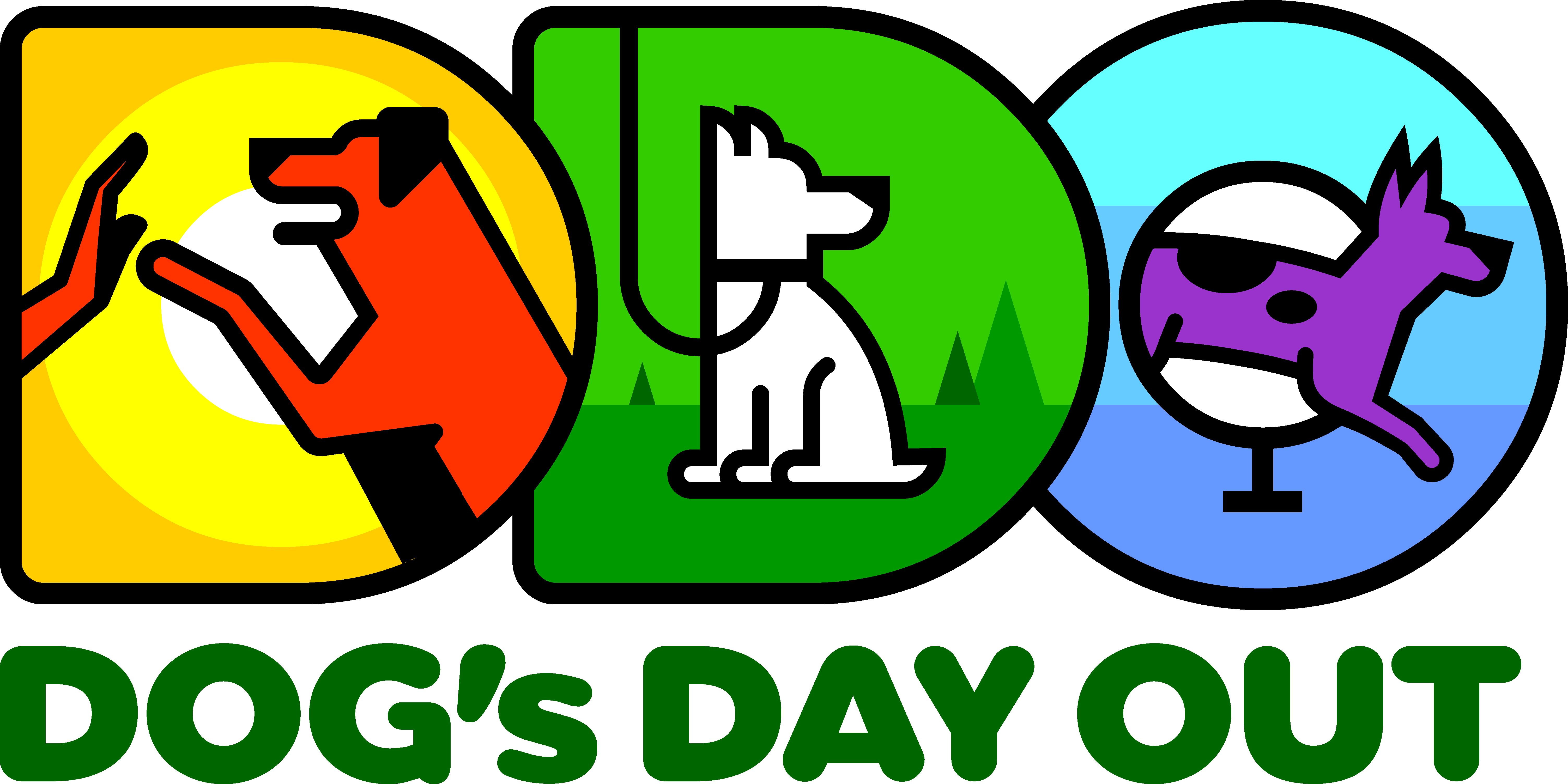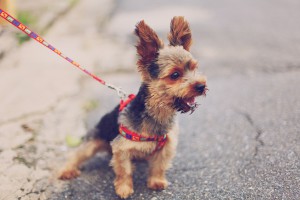I have worked with a LOT of reactive dogs for a LONG time now. As my city has become more populated and people are living in closer proximity to each other, I have seen the number of reactive dogs grow exponentially. To start, for ease of discussion we refer to these dogs as “reactive dogs” but I think it is important to note these are really just “dogs presenting reactive behaviors in certain circumstances.” That is kind of a mouthful, so I may refer to these dogs as “reactive dogs” but I’m guessing your “reactive dog” may just be chilling on the couch as you read this and I know that the vast majority of these dogs are perfectly wonderful dogs when not exposed to their trigger!
Below is a general protocol to be used for dogs who are lunging/barking/pulling towards certain triggers (dogs, people, cars etc.) when on a leashed walk. While I offer up this protocol, keep in mind the end goal would be for you to not have to cue (tell) your dog to do anything in the presence of her trigger and instead, just have her normal/natural response to the trigger be to ignore it/look at you/look away etc.
To start, in order to apply the best techniques for your particular dog, you will want to figure out the root cause/s of your dog’s reactivity. In the majority of cases, dogs are reactive for the following reasons (or a combination):
- Fear-based – not exclusive to, but often common with small dogs and mature dogs. These dogs may also be nervous or anxious in other environments. The dog is reacting to INCREASE distance from the trigger.
- Frustration and impulsivity, or “frustrated greeters” – often adolescent dogs who play well with other dogs off-leash. “I really, really, really want to say HI!!!!!!” The dog is trying to DECREASE distance from the trigger.
- Conflicted dogs – these dogs can exhibit behaviors of both of the above.
- Critter chasers – these dogs like to chase small, furry things that run. They may also feel the same about moving vehicles like cars, bikes, skateboards…. This type of reactivity is different from the above in that the dog is neither reactive to increase or decrease distance from the trigger but instead, because it is fun to chase! We deal with this type of reactive behavior a bit differently than addressed here but teaching a Leave It can be a good start 🙂
For dogs who are reacting solely from a lack of impulse control you can skip right to OPERANT CONDITIONING below (or at least jump there rather quickly) however, it certainly doesn’t hurt to treat your dog when you see other dogs/triggers either. For fearful dogs however, because we want to change the way your dog FEELS about the trigger, we start the protocol with Counterconditioning and Desensitization then move to Operant Conditioning (DRO’s), Emergency Cues and Additional Techniques.
*NOTE: Even though we (humans) may be focusing on one of these at a time, keep in mind that CC & OC are not mutually exclusive and that dogs are always learning from their environment. We are never really doing just one of these at a time. Even when we are focusing on (classical) counterconditioning, we can look for (and select) behaviors our dog is offering up and then choose to reinforce those specific behaviors, thus using operant conditioning too. It is important to be aware that both classical and operant learning are happening at the same time even though we may be focusing on one at a time. Our dogs are taking notes from everywhere!
COUNTERCONDITIONING AND DESENSITIZATION
- In CCDS we are making a direct correlation between the trigger and something the dog loves (food works!).
- The dog sees the trigger and then we give the dog a high-value treat.
- We are NOT NECESSARILY WAITING FOR GOOD BEHAVIOR here, we are just making an association.
- “Trigger goes by = hot dogs fall from the sky” Although it may be as simple as this, there is one way to mess this up and that is the ORDER in which your dog sees the trigger and when you present the food…
- Your dog MUST notice the trigger 1st and THEN you present the treat.
- CC/DS is NOT just distracting the dog with treats! If YOU see the trigger and then try to “distract” your dog with food before he sees it, and then he sees the trigger after you present the treat, you may be “poisoning” the treat in that now, you presenting the treat is an indication to your dog that a trigger is near. Oooops.
- It is imperative to keep the dog UNDER THRESHOLD – at a distance far enough away from the trigger for the dog to be able to see the trigger and NOT react (barking/lunging etc.).

OPERANT CONDITIONING (DRO – Differential Reinforcement of Other Behaviors)
- Sustained direct eye contact (usually more that 3 seconds) with any trigger usually does not end well so, I generally start with 3 (maybe 4) foundation skills that get the dog’s eye contact away from the trigger. These are : Find It, Treat Magnet (having the dog follow a lure), the Attention Game and (maybe) Touch. Again, my end goal is not to have to cue (tell my dog) to do these at all (I am working for his normal/natural behavior to look at me/look away/down etc. from the trigger) but initially, I think these 3 skills give the human some skills to pull out to help get that eye contact removed when needed.
- Teach the dog alternate behaviors: Touch, Sit, Wait, Leave It (great help for bird and squirrel chasing) and tricks like Bow & Peek-a-boo (stand between handler’s legs).
EMERGENCY EXITS
Remember, our ultimate goal for reactive dog training is to change how our dog feels (and thus how they respond) to their triggers. Meaning, we no longer have to “tell our dog what to do” on a walk, rather, by changing his emotional state around the trigger, we can change his behavior and his response. As we work towards that ultimate goal, we may have to teach our dog some specific cues to ” get us out of the moment.” Here are some I teach:
- Find It/Scatter Feed – say “find it, ” wait one second, then drop food on ground. This should be done is lots of different environments, not just when trigger is present. “Find it” is a game that brings the dog’s head to the ground and avoids any hard staring or direct eye contact.
- Emergency U-turn on a cue (“whoops”).
- “Squish”- this is a tight front where you continuously treat our dog for being squished in front of you. This can be used when you are stuck in a hallway or trail where you have no option of getting distance.
- “Treat Magnet” – teaching your dog to follow a lure (their nose to your fist) to get from point A to point B when the situation is dicey.
ADDITIONAL TECHNIQUES THAT MAY BE HELPFUL FOR YOUR DOG
- Engage/Disengage Game
- Pattern Games by Leslie McDevitt such as: The 1-2-3 game.
- Behavior Adjustment Training (BAT)
- Teach Go Say Hi to dogs who are reacting because they are impulsive or frustrated.
- Play The Counting Game (thanks Chirag Patel!)
- Work with a clicker or verbal marker to capture (no cue needed) desirable behaviors.
- Teaching your dog to relax with Go to Mat and Add-a-Count
We cover all of this (and more!) in our Reactive Rehab group class and seminar. One of the biggest obstacles for working with leash reactive dogs is being able to do “set-ups” while keeping the dog under threshold. A well-run, positive group class for reactive dogs can be very effective to providing this so please seek the help of a professional if needed.
More articles can be found on the Dog’s Day Out Reactive Dog Board on Pinterest.

